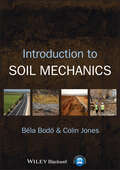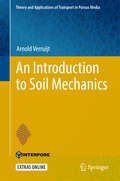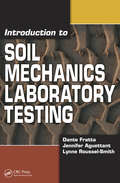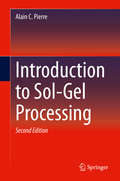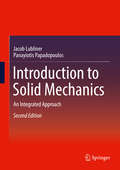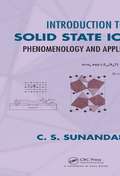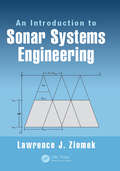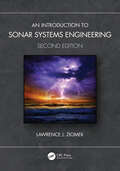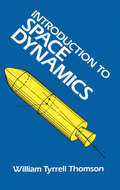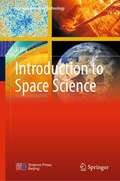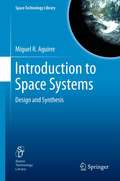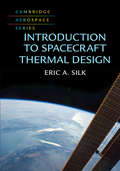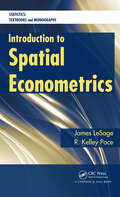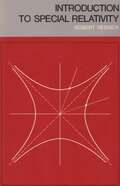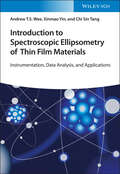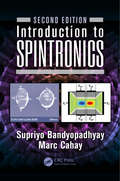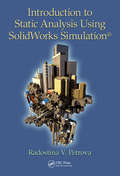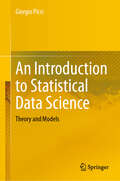- Table View
- List View
Introduction to Soil Mechanics
by Béla Bodó Colin JonesIntroduction to Soil Mechanics, Béla Bodó & Colin Jones Introduction to Soil Mechanics covers the basic principles of soil mechanics, illustrating why the properties of soil are important, the techniques used to understand and characterise soil behaviour and how that knowledge is then applied in construction. The authors have endeavoured to define and discuss the principles and concepts concisely, providing clear, detailed explanations, and a well-illustrated text with diagrams, charts, graphs and tables. With many practical, worked examples and end-of-chapter and coverage of Eurocode 7, Introduction to Soil Mechanics will be an ideal starting point for the study of soil mechanics and geotechnical engineering. About the Authors Béla Bodó B.Sc., B.A., C.Eng., M.I.C.E, was born in Hungary and studied at Budapest Technical University, the University of London and the Open University. He developed his expertise in Soil Mechanics during his employment with British Rail and British Coal. Colin Jones B.Sc, C. Eng., M.I.C.E, P.G.C.E, studied at the University of Dundee, and worked at British Coal where he and Béla were colleagues. He has recently retired from the University of Wales, Newport where he was Programme Director for the Civil Engineering provision, specializing in Soil Mechanics and Geotechnics. Also Available Fundamentals of Rock Mechanics 4th Edition J C Jaeger, N G W Cook and R Zimmerman Hardcover: 9780632057597 Smith's Elements of Soil Mechanics 8th Edition Ian Smith Paperback: 9781405133708
An Introduction to Soil Mechanics (Theory and Applications of Transport in Porous Media #30)
by Arnold VerruijtThis textbook offers a superb introduction to theoretical and practical soil mechanics. Special attention is given to the risks of failure in civil engineering, and themes covered include stresses in soils, groundwater flow, consolidation, testing of soils, and stability of slopes. Readers will learn the major principles and methods of soil mechanics, and the most important methods of determining soil parameters both in the laboratory and in situ. The basic principles of applied mechanics, that are frequently used, are offered in the appendices. The author's considerable experience of teaching soil mechanics is evident in the many features of the book: it is packed with supportive color illustrations, helpful examples and references. Exercises with answers enable students to self-test their understanding and encourage them to explore further through additional online material. Numerous simple computer programs are provided online as Electronic Supplementary Material. As a soil mechanics textbook, this volume is ideally suited to supporting undergraduate civil engineering students.
Introduction to Soil Mechanics Laboratory Testing
by Dante Fratta Jennifer Aguettant Lynne Roussel-SmithA step-by-step text on the basic tests performed in soil mechanics, Introduction to Soil Mechanics Laboratory Testing provides procedural aids and elucidates industry standards. It also covers how to properly present data and document results. Containing numerical examples and figures, the information presented is based on American Society f
Introduction to Soils and Soil Science: Laboratory Exercises
by Murray H. MilfordLab Manual that explores soil science
An Introduction to Soils for Environmental Professionals
by Duane L. WinegardnerAn Introduction to Soils for Environmental Professionals assembles and presents the basic principles of each of the major soil science fields. It introduces fundamental concepts and shows the interrelationships between the various branches of soil science - from mineralogy to soil physics.
Introduction to Sol-Gel Processing (International Series In Sol-gel Processing #1)
by Alain C. PierreThis book presents a broad, general introduction to the processing of Sol-Gel technologies. This updated volume serves as a general handbook for researchers and students entering the field. This new edition provides updates in fields that have undergone rapid developments, such as Ceramics, Catalysis, Chromatropgraphy, biomaterials, glass science, and optics. It provides a simple, compact resource that can also be used in graduate-level materials science courses.
Introduction to Solid Mechanics
by Jacob Lubliner Panayiotis PapadopoulosIntroduction to Solid Mechanics: An Integrated Approach presents for the first time in one text the concepts and processes covered in statics and mechanics of materials curricula following a granular, topically integrated approach. Since the turn of the millennium, it has become common in engineering schools to combine the traditional undergraduate offerings in rigid-body statics (usually called "statics") and deformable body mechanics (known traditionally as "strength of materials" or, more recently, "mechanics of materials") into a single, introductory course in solid mechanics. Many textbooks for the new course sequentially meld pieces of existing, discrete books--sometimes, but not always, acknowledging the origin--into two halves covering Statics and Mechanics of Materials. In this volume, Professors Lubliner and Papadopoulos methodically combine the essentials of statics and mechanics of materials, illustrating the relationship of concepts throughout, into one "integrated" text. Introduction to Solid Mechanics: An Integrated Perspective offers a holistic treatment of the depth and breadth of solid mechanics, proceeding from first principles to applications.
Introduction to Solid Mechanics: An Integrated Approach
by Jacob Lubliner Panayiotis PapadopoulosThis expanded second edition presents in one text the concepts and processes covered in statics and mechanics of materials curricula following a systematic, topically integrated approach. Building on the novel pedagogy of fusing concepts covered in traditional undergraduate courses in rigid-body statics and deformable body mechanics, rather than simply grafting them together, this new edition develops further the authors’ very original treatment of solid mechanics with additional figures, an elaboration on selected solved problems, and additional text as well as a new subsection on viscoelasticity in response to students’ feedback. Introduction to Solid Mechanics: An Integrated Approach, Second Edition, offers a holistic treatment of the depth and breadth of solid mechanics and the inter-relationships of its underlying concepts. Proceeding from first principles to applications, the book stands as a whole greater than the sum of its parts.
Introduction to Solid State Ionics: Phenomenology and Applications
by C. S. SunandanaIntroduction to Solid State Ionics: Phenomenology and Applications presents a pedagogical, graduate-level treatment of the science and technology of superionic conductors, also known as fast ion conductors or solid electrolytes. Suitable for physics, materials science, and engineering researchers and students, the text emphasizes basic physics and
Introduction to SolidWorks: A Comprehensive Guide with Applications in 3D Printing
by Godfrey C. OnwuboluThis senior undergraduate level textbook is written for Advanced Manufacturing, Additive Manufacturing, as well as CAD/CAM courses. Its goal is to assist students in colleges and universities, designers, engineers, and professionals interested in using SolidWorks as the design and 3D printing tool for emerging manufacturing technology for practical applications. This textbook will bring a new dimension to SolidWorks by introducing readers to the role of SolidWorks in the relatively new manufacturing paradigm shift, known as 3D-Printing which is based on Additive Manufacturing (AM) technology. This new textbook: Features modeling of complex parts and surfaces Provides a step-by-step tutorial type approach with pictures showing how to model using SolidWorks Offers a user-Friendly approach for the design of parts, assemblies, and drawings, motion-analysis, and FEA topics Includes clarification of connections between SolidWorks and 3D-Printing based on Additive Manufacturing Discusses a clear presentation of Additive Manufacturing for Designers using SolidWorks CAD software "Introduction to SolidWorks: A Comprehensive Guide with Applications in 3D Printing" is written using a hands-on approach which includes a significant number of pictorial descriptions of the steps that a student should follow to model parts, assemble parts, and produce drawings.
An Introduction to Sonar Systems Engineering
by Lawrence J. ZiomekWritten in tutorial style, this textbook discusses the fundamental topics of modern day Sonar Systems Engineering for the analysis and design of both active and passive sonar systems. Included are basic signal design for active sonar systems and understanding underwater acoustic communication signals. Mathematical theory is provided, plus practical design and analysis equations for both passive and active sonar systems. Practical homework problems are included at the end of each chapter and a solutions manual and lecture slides for each chapter are available for adopting professors.
An Introduction to Sonar Systems Engineering
by Lawrence J. ZiomekAn Introduction to Sonar Systems Engineering Second Edition Important topics that are fundamental to the understanding of modern-day sonar systems engineering are featured. Linear, planar, and volume array theory, including near-field and far-field beam patterns, beam steering, and array focusing, are covered. Real-world arrays such as the twin-line planar array and a linear array of triplets, which are solutions to the port/starboard (left/right) ambiguity problem associated with linear towed arrays, are examined in detail. Detailed explanations of the fundamentals of side-looking (side-scan) and synthetic-aperture sonars are presented. Bistatic scattering with moving platforms is explored with derivations of exact solutions for the time delay, time-compression/time-expansion factor, and Doppler shift at a receiver for both the scattered and direct acoustic paths. Time-domain and frequency-domain descriptions, and the design of CW, LFM, and Doppler-invariant HFM pulses, are explained. Target detection in the presence of reverberation and noise is examined. Time-domain and frequency-domain descriptions of MFSK, MQAM, and OFDM underwater acoustic communication signals are also discussed. Although the book is mathematically rigorous, it is written in a tutorial style. Many useful, practical design and analysis equations for both passive and active sonar systems are derived from first principles. No major steps in the derivation of important results are skipped – all assumptions and approximations are clearly stated. Particular attention is paid to the correct units for functions and parameters. Many figures, tables, examples, and practical homework problems at the end of each chapter are included to aid in the understanding of the material covered. New to the Second Edition Chapter 15 Synthetic-Aperture Sonar Chapter 13, Section 13.3, The Rectangular-Envelope HFM Pulse Chapter 10, Section 10.7, Moving Platforms, was rewritten, which allowed for the elimination of Appendix 10C from the first edition New explanations/discussions were added to Subsections 1.2.1 and 1.3.1 in Chapter 1 Appendix 1A was rewritten and the new Table 1A-1 was added to Chapter 1 A solutions manual is available for adopting professors
Introduction to Sonar Transducer Design
by John C. CochranINTRODUCTION TO SONAR TRANSDUCER DESIGN A comprehensive introduction to sonar transducer design, complete with real world examples, step-by-step instruction, and detailed mathematical review In Introduction to Sonar Transducer Design, renowned sensor engineer Dr. John C. Cochran delivers an instructive and comprehensive exploration of the foundations of sonar transducer design perfect for beginning and experienced professional transducer designers. The book offers a detailed mathematical review of the subject, as well as fulsome design examples. Beginning with a description of acoustic wave propagation, along with a review of radiation from a variety of sources, the book moves on to discuss equivalent circuit models that explain wave propagation in solids and liquids. The book reviews examples of projectors and hydrophones accompanied by complete mathematical solutions. All included math is developed from first principles to a final solution using an intuitive, step-by-step approach. Introduction to Sonar Transducer Design offers professionals and students the analytical tools and assumptions required for start-to-finish transducer design. It also provides: A thorough introduction to acoustic waves and radiation, including small signals, linear acoustics, the equations of continuity, motion, the wave equation in a fluid media, and integral formulations Comprehensive explorations of the elements of transduction, including various forms of impedance, and mechanical and acoustical equivalent circuits, as well as their combination Practical discussions of waves in solid media, including homogeneous, isotropic, elastic, and solid media, piezoelectricity and piezoelectric ceramic materials, and waves in non-homogeneous, piezoelectric media In-depth examinations of sonar projectors and sonar hydrophones, including the elements and tools of sonar projector and sonar hydrophone design, as well as their applications Perfect for sonar system engineers, particularly those involved in defense, Introduction to Sonar Transducer Design will also earn a place in the libraries of acoustic, audio, underwater communication, and naval engineers.
Introduction to Space Dynamics
by William Tyrrell ThomsonAlthough this classic introduction to space-flight engineering was first published not long after Sputnik was launched, the fundamental principles it elucidates are as varied today as then. The problems to which these principles are applied have changed, and the widespread use of computers has accelerated problem-solving techniques, but this book is still a valuable basic text for advanced undergraduate and graduate students of aerospace engineering.The first two chapters cover vector algebra and kinematics, including angular velocity vector, tangential and normal components, and the general case of space motion. The third chapter deals with the transformation of coordinates, with sections of Euler's angles, and the transformation of angular velocities.A variety of interesting problems regarding the motion of satellites and other space vehicles is discussed in Chapter 4, which includes the two-body problem, orbital change due to impulsive thrust, long-range ballistic trajectories, and the effect of the Earth's oblateness. The fifth and sixth chapters describe gyrodynamics and the dynamics of gyroscopic instruments, covering such topics as the displacement of a rigid body, precession and nutation of the Earth's polar axis, oscillation of the gyrocompass, and inertial navigation.Chapter 7 is an examination of space vehicle motion, with analyses of general equations in body conditions and their transformation to inertial coordinates, attitude drift of space vehicles, and variable mass. The eighth chapter discusses optimization of the performance of single-stage and multistage rockets. Chapter 9 deals with generalized theories of mechanics, including holonomic and non-holonomic systems, Lagrange's Equation for impulsive forces, and missile dynamics analysis.Throughout this clear, comprehensive text, practice problems (with answers to many) aid the student in mastering analytic techniques, and numerous charts and diagrams reinforce each lesson. 1961 edition.
Introduction to Space Science (Springer Aerospace Technology)
by Ji WuThis book highlights the technological and managerial fundamentals and frontier questions of space science. Space science is a new interdisciplinary and comprehensive subject that takes spacecraft as the main tools to study the planet Earth, the solar-terrestrial space, the solar system, and even the whole universe, to answer significant questions covering the formation and evolution of the solar system and the universe, the origin and evolution of life and the structure of the material. The book introduces major scientific questions in various branches of space science and provides related technological and managerial knowledge. It also discusses the necessity of international cooperation and elaborates on the strategic planning of space science in China. The book can be used as a reference book or textbook for scientists, engineers, college students, and the public participating in space science programs.
Introduction to Space Syntax in Urban Studies
by Akkelies van Nes Claudia YamuThis open access textbook is a comprehensive introduction to space syntax method and theory for graduate students and researchers. It provides a step-by-step approach for its application in urban planning and design. This textbook aims to increase the accessibility of the space syntax method for the first time to all graduate students and researchers who are dealing with the built environment, such as those in the field of architecture, urban design and planning, urban sociology, urban geography, archaeology, road engineering, and environmental psychology. Taking a didactical approach, the authors have structured each chapter to explain key concepts and show practical examples followed by underlying theory and provided exercises to facilitate learning in each chapter. The textbook gradually eases the reader into the fundamental concepts and leads them towards complex theories and applications. In summary, the general competencies gain after reading this book are:– to understand, explain, and discuss space syntax as a method and theory;– be capable of undertaking various space syntax analyses such as axial analysis, segment analysis, point depth analysis, or visibility analysis;– be able to apply space syntax for urban research and design practice;– be able to interpret and evaluate space syntax analysis results and embed these in a wider context;– be capable of producing new original work using space syntax.This holistic textbook functions as compulsory literature for spatial analysis courses where space syntax is part of the methods taught. Likewise, this space syntax book is useful for graduate students and researchers who want to do self-study. Furthermore, the book provides readers with the fundamental knowledge to understand and critically reflect on existing literature using space syntax.
Introduction to Space Systems
by Miguel A. AguirreThe definition of all space systems starts with the establishment of its fundamental parameters: requirements to be fulfilled, overall system and satellite design, analysis and design of the critical elements, developmental approach, cost, and schedule. There are only a few texts covering early design of space systems and none of them has been specifically dedicated to it. Furthermore all existing space engineering books concentrate on analysis. None of them deal with space system synthesis - with the interrelations between all the elements of the space system. Introduction to Space Systems concentrates on understanding the interaction between all the forces, both technical and non-technical, which influence the definition of a space system. This book refers to the entire system: space and ground segments, mission objectives as well as to cost, risk, and mission success probabilities. Introduction to Space Systems is divided into two parts. The first part analyzes the process of space system design in an abstract way. The second part of the book focuses on concrete aspects of the space system design process. It concentrates on interactions between design decisions and uses past design examples to illustrate these interactions. The idea is for the reader to acquire a good insight in what is a good design by analyzing these past designs.
Introduction to Spacecraft Thermal Design (Cambridge Aerospace Series #48)
by Eric A. SilkDevelop a fundamental understanding of heat transfer analysis techniques as applied to earth based spacecraft with this practical guide. Written in a tutorial style, this essential text provides a how-to manual tailored for those who wish to understand and develop spacecraft thermal analyses. Providing an overview of basic heat transfer analysis fundamentals such as thermal circuits, limiting resistance, MLI, environmental thermal sources and sinks, as well as contemporary space based thermal technologies, and the distinctions between design considerations inherent to room temperature and cryogenic temperature applications, this is the perfect tool for graduate students, professionals and academic researchers.
An Introduction to Spatial Data Science with GeoDa: Volume 2: Clustering Spatial Data
by Luc AnselinThis book is the second in a two-volume series that introduces the field of spatial data science. It moves beyond pure data exploration to the organization of observations into meaningful groups, i.e., spatial clustering. This constitutes an important component of so-called unsupervised learning, a major aspect of modern machine learning.The distinctive aspects of the book are both to explore ways to spatialize classic clustering methods through linked maps and graphs, as well as the explicit introduction of spatial contiguity constraints into clustering algorithms. Leveraging a large number of real-world empirical illustrations, readers will gain an understanding of the main concepts and techniques and their relative advantages and disadvantages. The book also constitutes the definitive user’s guide for these methods as implemented in the GeoDa open source software for spatial analysis.It is organized into three major parts, dealing with dimension reduction (principal components, multidimensional scaling, stochastic network embedding), classic clustering methods (hierarchical clustering, k-means, k-medians, k-medoids and spectral clustering), and spatially constrained clustering methods (both hierarchical and partitioning). It closes with an assessment of spatial and non-spatial cluster properties.The book is intended for readers interested in going beyond simple mapping of geographical data to gain insight into interesting patterns as expressed in spatial clusters of observations. Familiarity with the material in Volume 1 is assumed, especially the analysis of local spatial autocorrelation and the full range of visualization methods.Luc Anselin is the Founding Director of the Center for Spatial Data Science at the University of Chicago, where he is also Stein-Freiler Distinguished Service Professor of Sociology and the College, as well as a member of the Committee on Data Science. He is the creator of the GeoDa software and an active contributor to the PySAL Python open-source software library for spatial analysis. He has written widely on topics dealing with the methodology of spatial data analysis, including his classic 1988 text on Spatial Econometrics. His work has been recognized by many awards, such as his election to the U.S. National Academy of Science and the American Academy of Arts and Science.
Introduction to Spatial Econometrics (Statistics: A Series of Textbooks and Monographs)
by James LeSage Robert Kelley PaceAlthough interest in spatial regression models has surged in recent years, a comprehensive, up-to-date text on these approaches does not exist. Filling this void, Introduction to Spatial Econometrics presents a variety of regression methods used to analyze spatial data samples that violate the traditional assumption of independence between observat
Introduction To Special Relativity
by Robert ResnickThis book gives an excellent introduction to the theory of special relativity. Professor Resnick presents a fundamental and unified development of the subject with unusually clear discussions of the aspects that usually trouble beginners. He includes, for example, a section on the common sense of relativity. His presentation is lively and interspersed with historical, philosophical and special topics (such as the twin paradox) that will arouse and hold the reader's interest. You'll find many unique features that help you grasp the material, such as worked-out examples, summary tables, thought questions and a wealth of excellent problems. The emphasis throughout the book is physical.
Introduction to Spectroscopic Ellipsometry of Thin Film Materials: Instrumentation, Data Analysis, and Applications
by Andrew Thye Wee Xinmao Yin Chi Sin TangA one-of-a-kind text offering an introduction to the use of spectroscopic ellipsometry for novel material characterization In Introduction to Spectroscopic Ellipsometry of Thin Film Materials: Instrumentation, Data Analysis and Applications, a team of eminent researchers delivers an incisive exploration of how the traditional experimental technique of spectroscopic ellipsometry is used to characterize the intrinsic properties of novel materials. The book focuses on the scientifically and technologically important two-dimensional transition metal dichalcogenides (2D-TMDs), magnetic oxides like manganite materials, and unconventional superconductors, including copper oxide systems. The distinguished authors discuss the characterization of properties, like electronic structures, interfacial properties, and the consequent quasiparticle dynamics in novel quantum materials. Along with illustrative and specific case studies on how spectroscopic ellipsometry is used to study the optical and quasiparticle properties of novel systems, the book includes: Thorough introductions to the basic principles of spectroscopic ellipsometry and strongly correlated systems, including copper oxides and manganites Comprehensive explorations of two-dimensional transition metal dichalcogenides Practical discussions of single layer graphene systems and nickelate systems In-depth examinations of potential future developments and applications of spectroscopic ellipsometryPerfect for master’s- and PhD-level students in physics and chemistry, Introduction to Spectroscopic Ellipsometry of Thin Film Materials will also earn a place in the libraries of those studying materials science seeking a one-stop reference for the applications of spectroscopic ellipsometry to novel developed materials.
Introduction to Spintronics
by Supriyo Bandyopadhyay Marc CahayIntroduction to Spintronics provides an accessible, organized, and progressive presentation of the quantum mechanical concept of spin and the technology of using it to store, process, and communicate information. Fully updated and expanded to 18 chapters, featuring many new drill problems, this edition reflects the explosion of study in spin-related physics, addressing seven important physical phenomena with spintronic device applications. It discusses spintronics without magnetism, which allows one to manipulate spin currents by purely electrical means. It explores lateral spin-orbit interaction and its many nuances, as well as the possibility to implement spin polarizers and analyzers using quantum point contacts. It also introduces the concept of single-domain-nanomagnet-based computing.
Introduction to Static Analysis Using SolidWorks Simulation
by Radostina V. PetrovaUses Finite Element Analysis (FEA) as Implemented in SolidWorks SimulationOutlining a path that readers can follow to ensure a static analysis that is both accurate and sound, Introduction to Static Analysis using SolidWorks Simulation effectively applies one of the most widely used software packages for engineering design to the concepts of static
An Introduction to Statistical Data Science: Theory and Models
by Giorgio PicciThis graduate textbook on the statistical approach to data science describes the basic ideas, scientific principles and common techniques for the extraction of mathematical models from observed data. Aimed at young scientists, and motivated by their scientific prospects, it provides first principle derivations of various algorithms and procedures, thereby supplying a solid background for their future specialization to diverse fields and applications. The beginning of the book presents the basics of statistical science, with an exposition on linear models. This is followed by an analysis of some numerical aspects and various regularization techniques, including LASSO, which are particularly important for large scale problems. Decision problems are studied both from the classical hypothesis testing perspective and, particularly, from a modern support-vector perspective, in the linear and non-linear context alike. Underlying the book is the Bayesian approach and the Bayesian interpretation of various algorithms and procedures. This is the key to principal components analysis and canonical correlation analysis, which are explained in detail. Following a chapter on nonlinear inference, including material on neural networks, the book concludes with a discussion on time series analysis and estimating their dynamic models. Featuring examples and exercises partially motivated by engineering applications, this book is intended for graduate students in applied mathematics and engineering with a general background in probability and linear algebra.
